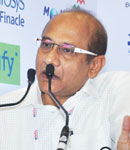|
The Indian cooperative sector is the largest in the world and it plays a very important role in employment generation, poverty alleviation and ensuring food security. Gujarat is well known as the home to cooperative Banking, agricultural and dairy cooperatives also changed their style of functioning according to the technological changes. Elets Technomedia Pvt Ltd, along with the Gujarat Urban Cooperative Bank Federation (GUCBF), organised the ‘Gujarat Cooperatives Summit’ at Mahatma Mandir, Gandhinagar on 22nd June 2015. The focus here was primarily on the Cooperative Banking Sector in Gujarat. Chairmen and Managing Directors of around 150 cooperative banks participated in this conference and had long discussion on several aspects of the sector. The key objective behind focusing on the Cooperative Banking Sector was to understand how the banks have emerged out of the major infamous Madhavpura Mercantile Scam of 2001, which shook the entire cooperative banking industry and questions were asked about its very existence. The participants tried to understand the challenges faced today and talked about the initiatives that should be undertaken by the cooperative banks, along with the Government of Gujarat, to regain the lost confidence of its customers. |
|
Session: Special Address Improving Health Mona Khandhar, Secretary, Cooperation, Government of Gujarat |
|
Inaugural Session : Revolutionising of Indian Cooperative Sector Cooperatives for all Ghanshyam Amin, President, Gujarat State Cooperative Union and Chairman, Cooperative Bank of India. It has been accepted globally by over 118 countries in the world that if one wants to reach the rural population at large and provide them services, then cooperative bodies are the best available instrument. That being the reason, some 98 countries have joined hands and formed ICA (International Cooperatives Alliance). The best example of success of the Cooperatives is uplift of rural economy through formation of Primary Agriculture Cooperative Societies involving farmers at each level. Availability of reasonably-priced fertilisers, seeds, loans and advances required for farming, and right prices for the products has been ensured successfully by these village-based societies. The Cooperatives are actually doing the work of improving the economic situation of the rural population at large. However, there is an urgent need of adopting professional approach in the management of the Cooperatives, especially in banks, to fight against the competition from major commercial banks. The cooperative banks will have to adapt to the professional management style adopted by professional nationalised banks. |
|
Collective leadership R N Joshi, Chief Executive Officer, Gujarat Urban Cooperative Banks Federation (GUCBF). which the Gujarat Government, along with the Reserve Bank of India, took proactive steps to revive the entire sector. This has been possible primarily because of the discipline and a spirit of cooperation we are carrying together. Today, we are a team of 226 cooperative banks having more than 1 crore depositors. This shows that the people at large have faith in Urban Banking and Urban Credit. In the last 10 years, we have tried to move on to the ladder of technology through the use of Core Banking Solution (CBS), and we are pushing forward by implementing Mobile Banking, eGovernance and various others new-age techniques. We have been able to bring in a significant change in our way of working and managing the day-to-day operations. In the coming days, we would be facing challenges from three quarters called institution challenges: (a) Payment Banks (b) Small Banks and (c) Postal Banking. Payment banks, where currently the deposit and other services can be provided only up to 1 lakh, can take a major chunk of business away from the cooperative banks. Small banks, like Bandhan Bank, have entered the market recently and will pose challenges, especially in the North and East parts of the country. Small banks can give advances up to 25 lakh and will work more as a funding bank. They will work in unbanked areas and will provide the facilities as a mini bank; also will provide a big challenge for our survival. Then, postal banks have a vast reach and will give competition, especially in talukas and urban areas in the country, which we need to think about. Apart from this we are already facing a major competition and threat to our business from other financial market players like Credit Card & Debit Card operators, NBFCs and the likes. |
|
Integrated cooperatives Dr S O Junare, Director, National Institute of Co-operative Management, Gandhinagar, Gujarat Today, in India, around 75-80 per cent farmers are small farmers and the 66 per cent of total loans or advances to these farmers is provided by the small credit cooperative societies. The private or nationalised banks majorly cater to HNIs (High Networth Individuals), while the cooperative banks and credit cooperative societies take care of the credit need of small and marginal farmers. The cooperatives are working in risky areas since the beginning of the cooperative movement in 1946 in India, as that is what they stand for. The cooperatives in Gujarat are successful in Agriculture, Dairy and Banking sectors. But we need to further consolidate the foundation, as we still remain weak in cotton processing, oil seeds and fisheries. Another important model is the Integrated Cooperative Model, wherein the members get all the benefits and facilities. There are a lot of good things happening in the cooperative sector, but there’s not much publicity about these. |
|
Growing beyond Madhavpura N V Patel, Chairman, Vadodara Urban Development Authority (VUDA) Adoption of good marketing strategy by the cooperatives banks is also necessary to be successful in the coming years. In the future, new bank branches could be ‘building-less’. Everything would be required to be done using latest technology through smart phones and laptops to online internet banking. The need of the hour is Smart Banking and to achieve it, we need to work on capacity building and training of our existing manpower. GUCBF has also started a new initiative by the name Center for Banking Research Development and Excellence. |
|
Big brothers to aid small ones Dollar Kotecha, Vice Chairman, Gujarat Urban Cooperative Bank Federation |
|
Session 2 : Challenges & Strategy to Compete with Private and National level Banks Skill, Scale and Speed R N Joshi, Chief Executive Officer, Gujarat Urban Cooperative Banks Federation Tapping of savings is the first step of Financial Inclusion. In Gujarat, this savings is 30.19 per cent of GDP, i.e. around 1.90 lakh crore. Another area that needs to be tapped is non- earning members of the State. At least 3.6 crore people in Gujarat are non-earning members. One can also bring in Women Entrepreneurs. Women can be encouraged to participate in five sectors, viz, technology-related businesses, engineering and architecture, finance and publication, child care and health – care, and event management and Entertainment. Cooperative banks can cover the marginalised section of society, who need houses through housing loans. Hence, financial inclusion can emerge only when cooperative banks are able to mobilise savings. Implementation of efficient and cost-effective banking solutions is also a major challenge to many banks. By March 2016, all cooperative banks will be in CBS Net. |
|
Skilling for capacity enhancement  Chairman, Vadodara Urban Development Authority (VUDA) The basic challenge faced by many banks today is development of their human resources, especially those who are with banks for many years. The appraisal criteria of the manpower will have to be defined properly. Also, marketing of the services needs to be improved. There are going to be two types of clients in the future – the ones who are going to come in the banks to do transaction and the others, who are not going to come to the bank. For other set of clients, technology adoption is the only solution. We are also going to face a major challenge from the post office sector, too, as all the post offices are expected to turn into banks, with a strong rural reach and network. The Government of Gujarat has done an amendment in recent Cooperative Act and made it mandatory to have two women Directors in board and also one SC/ ST Director. RBI has suggested having two technocrats as Directors in the board. My suggestion would be to have at least one IT person in the board. This will help in facing the future challenges related to IT in a better way. Another suggestion to face the competition is to have and use the unemployed manpower on part time basis. |
|
HR – the Spinal cord Narendra Singh Dabhi, Managing Director, Adarsh Cooperative Bank Limited. |
|
Survival is the challenge  Former Executive Director, Reserve Bank of India The biggest challenge today for any cooperative bank is how to survive. Financial inclusion and technology are the two major aspects to the development of any cooperative bank. The cooperative banks will have to manage them innovatively as well as creatively. The State Government and the cooperative banks will have to work together to get every section of the society under financial inclusion. The State Government will have to enhance the skills of the employable youth, so that they can increase their income levels, can save and can then deposit in banks. Moreover, the customer will go to those banks where he can get services which he wants. He is now not loyal to any one, instead he will prefer to have all services under one roof. Today, the scale of the organisation matters instead of size. Governance is the major problem with respect to regulatory point of view. There should not be any political interference in the running of the bank. Moreover, there is a high risk of non-regulatory compliance with the sector. The track record is not good. The cooperative spirit is on a decline, because many of the banks are not member-driven. UCBs work in a very controlled environment. They are not allowed to raise the capital from the open market, the advances is limited only to the area of operations, there is not sub – sidy provided on the loans given to SSI units, there is no much freedom provided on home loans, forex business or any guarantee that is to be issued. There are many challenges for getting permission for putting up of onsite as well as off-site ATMs. Then, there is dual control today on UCBs – from Registrar as well as RBI. There is a need for having a single regulatory power and it is suggested to vest RBI for such powers. There is a need to have a deep thought for strengthening the audit function in cooperative banks. |
|
Go the tech-way Ajit Saijwani, Technology Advisor, Gujarat Urban Cooperatives Bank Federation (GUCBF) Adoption of technology is a must and helps in the growth of bank not only financially but also geographically. Mobile Banking is the future. It is the time to choose the right technology and more importantly right partner. Also, for business expansion one can have a tie-up with nationalised banks and can also go for more Micro ATMs. District banks are being provided the subsidy of 25,000 by Nabard for setting up Micro ATMS. |
|
Gandhinagar focal point for RICOH Subhankar Dutta, National Business Head, Ricoh India RICOH is committed to provide the best products and solutions to the cooperative banks in Gujarat. It is present for 25 years in the Indian market and has assembling facility established in Gandhinagar itself. The Gandhinagar facility is going to be a focal point for RICOH as it is the National Logistics Centre for the company. It is listed in NASSCOM and is in the top 40 players out of 6,500 players registered. 40 per cent people take loans from cooperative banks because of easy and flexible payment terms, while 35 per cent people take loans because of easy documentation. We have many clients in cooperative banks, like Shamrao Vithal Cooperative Bank Ltd, Andhra Pradesh Cooperative Bank and Saraswat Bank, and are now looking forward to the Gujarat Cooperative Banking Market. |
|
Session 3 : Technology in Banking and Financial Services – Core Banking Services and Payment Systems Smart Payment System Pushpinder Singh, Head- Financial Inclusion and New Business, National Payment Corporation of India (NPCI). |
|
Branchless banking
We provide branchless banking platform. Senrysa has specialised solutions and expertise in many areas of banking and financial services, including retail banking, wholesale banking, commercial banking, lending, auto finance, cash management, treasury solutions, corporate finance, mortgage and collections. |
|
Coop banks eye rural areas Bhavit Godiwala, Delivery Manager – India, North Asia and South East Asia, Finacle Infosys Ltd |
| COM-SUR tools for full security
Gautam Goradia, Chief Executive Officer, COMSUR Installation of CCTV cameras is just the first step of provisioning of Security Eye today. The installation of the CCTV is not only enough, we also need to check it on daily basis, as per the Government of India’s norms. The technology that COMSUR proposes takes the backup of entire system and records as a power point presentation. One can check the 24-hour footage of CCTV system in just one hour using software adopted by COMSUR. |
|
BBSL for skilled manpower Gnana Shekhran, Chief Executive Officer, Best of Breed Software Solutions Limited (BBSL). |
|
Money on Mobile Gaurav Zutshi, CEO, My Mobile Payments Ltd. ‘Money On Mobile’ is the RBI approved prepaid card issuer. Cooperative banks can provide the card to their customers who can do online shop – ping, book railway tickets, transfer money and can do various other such things that an ordinary debit card can, with absolute low technology cost. It is a unique out-of-the-box solution. |
|
Customer retention Rahil Patel, CISO, Kalupur Commercial Cooperative Bank Ltd. It’s very important today to provide all possible technology solutions to keep the customer with us. However, it’s not necessary to adopt all the available technologies for a cooperative bank; one should pick just the ones that are needed for providing better services to its clients. Advancements in technology have transformed cooperative banking, enabling the sector to provide many channels for customer service, customer attainment and retention. |
|
Session 4 : Special Presentation On-demand elastic model
Abir Banerjee, Assistant Vice President, Sify Technologies Pvt Ltd. We at Sify have a technology solution that can cater to the needs of group of cooperative banks through shared services. ‘Virtual machines’ is a reality today. It helps in bringing down the cost of providing services significantly. Thus, we propose ‘on-demand elastic model’ to our customers. |
|
Session 5 : Physical, Cyber Security and Risk Management in Banking Schneider Electric reduce costs Rahul Bisen, Channel Head- Rack and Cooling, Schneider Electric. Data Center in rack is the solution today offered to the cooperative banks. With our comprehensive data center infrastructure solutions, a targeted portfolio of software and life cycle services, Schneider Electric will help you increase your top line, reduce costs, ensure availability and limit your impact on global climate change. |
|
Beware of security threats Jayesh Chhatpar, Head IT, Rajkot Nagrik Sahakari Bank Limited. |
|
Trust and Confidence for security Jyotish Werulkar, Country Manager – Enterprise, Quick Heal Technologies Pvt. Ltd. |
|
Threat protection for seamless banking Vijender Katiyar, Regional Sales Head (West), Trend Micro. |
|
Safety and security Pratik Patel, Vice President, Biomatiques Identification Solutions Pvt. Ltd. |
|
Advanced modules for Cooperative Banks
|
Euronet provides comprehensive electronic solutions
Subhrata Sahay, Sr. General Manager Sales, Euronet Services India Pvt Ltd. |
|
Key Takeaways ◈ Gujarat has more than 70,000 cooperatives comprising of banks, housing, dairies, credit, sugar and Primary Agriculture Coop – erative Societies (PACS). ◈ The financial health as well as the services the cooperatives provide to its members are very important. ◈ Core banking is getting majorly implemented by district-level cooperative banks. ◈ Cooperative Organisations should be left behind and will have to take the technological help so as to fight against the growing competition. ◈ As per recent report of Reserve Bank of India, the rural advances in the cooperative banking sector is decreasing over a period of time and is approx 20 per cent of the total advances given especially by cooperative banks. However, these banks are of the view that the level playing field is not being provided to them as it is given to Nationalised and Private Banks. The facility of providing loans to the priority sector is given to nationalised banks as compared to cooperative banks. ◈ Nationalised banks give the priority lending especially to major and established farmers, while cooperative banks have to take care of marginal and small farmers. ◈ Also, the Indian Government provides more support and help to nationalised banks, by infusing financial help in case of instability in them. The same is not the case with cooperative banks. ◈ When the NPAs (Non – Performing Assets) of the cooperative banks rise, the responsibilities and ownership are in the hands of the management, while in nationalised banks, that’s not the case. The Government gets involved on regular basis and supports them in lowering of NPAs, by providing inclusion of financial support. ◈ The cooperative banks today in Gujarat are having deposit of more than ₹ 33,000 Crores and advances of more than ₹ 25,000 Crores. ◈ Today, over 140,000 litres of milk is collected daily through the milk cooperatives in Gujarat, and they are being paid weekly. Further, the price paid to them is higher than the market price, still AMUL (Anand Milk Union Limited) gave ₹ 500 crore back to these milk cooperatives as a price difference last year. This price difference was earned by marketing of additional by- products like butter, cheese, chocolates, curd and others. ◈ Recently, the Gujarat Government has given a special package of providing a 300 square yards plot of land and also the financial assistance of ₹ 500,000 to women involved in milk collection. ◈ IFFCO today is making approx ₹ 1,200 crore year on year. ◈ Bardoli Sugar Factory near Surat is producing huge quantity of sugar per day. ◈ In India, there are more than six lakh cooperative societies today, with over 26 crore members. ◈ The payment by credit card today is ₹ 192,263 crore per day by debit card, it is ₹ 23,49,365 crore; by ATM, it is ₹ 22,27,962 crore, POS use ₹ 1,21,039 crore and mobile banking is ₹ 1,03,00,530 crore. All these use the technology in some or the other way and is a big challenge to us. In Gujarat, where we have some 226 cooperative banks, 98 are grid banks and some 10 banks are unit banks with profit of less than ₹ 10 lakh per annum. How do we survive is the point to be thought about in such a scenario. ◈ Until and unless the banks do not work along with technology as a part of the Livelihood Mission, and do not take part in the Skill Development Mission, are unable to attract people through schemes like Jan- Dhan Yojana, these are going to face major challenges. ◈ Recently, TDS has been introduced in cooperative banking sector. ◈ Most of the people take loans from cooperative banks because of easy payment terms and easy documentation process. ◈ The urban cooperative banks needs to contribute to the vision of SKILL, SCALE and SPEED (3S), which is the vision document of Prime Minister’s Skill Development Programme. ◈ The federation on the other part is ready to help the banks to create a Livelihood Mission so as to generate more employment in the sector. ◈ Tapping of savings is the first step of financial inclusion. In Gujarat, this savings is 30.19 per cent of GDP i.e. around ₹ 1.90 lakh crore. ◈ Another area that needs to be tapped is non-earning members of the State. At least there are some 3.6 crore people in Gujarat, who are non-earning members. One can also bring in women entrepreneurs. Cooperative banks can cover the marginalised section of society that needs houses through housing loans. Hence, financial inclusion can emerge only when cooperative banks are able to mobilise savings. ◈ Implementation of efficient and cost- effective banking solutions is also a major challenge for many banks. The banks also need to look into establishment of business correspondents, who will help in generating more money for the banks. ◈ To fight against the competition, cooperative banks can adopt mobile banking and door step banking. ◈ The basic challenge faced by many banks today is the development of their human resources, especially those who are with banks since many years. The appraisal criteria of these manpower will have to be defined properly. ◈ There is a need for capacity enhancement. Also, marketing of the services needs to be improved. There are going to be two type of clients now onwards – one who are going to come in the banks to do transaction and others who are not going to come to the bank. ◈ There is going to be a major challenge from the post office sector, as all the post offices are expected to turn into banks, with a strong rural reach and network. For customers who want to go into the banks and do the transactions, the postal banks are going to pose a big challenge. ◈ It is better to have one IT Person in the board of directors. This will help in facing the future challenges related to IT in a better way. ◈ One of the suggestions to face the competition is to have and use the unemployed manpower on part-time basis on contract and make them move in the market for promoting the services by providing them with latest instruments. ◈ One needs to understand that the major use of having a CBS is not anywhere banking or having just a data transfer, instead it is having a proper MIS (Management Information System) too. ◈ Cooperation is in the DNA of a human being. Though we have many challenges in front of us, one should appreciate that we have more strengths to face them. ◈ To face the challenges and be successful, we need to bring the change in our working. And the first change should be adoption of Technology. ◈ Human Resource is the spinal cord of any organisation. Training to the existing manpower in the bank is required. There is also a strong need of empowering people through delegation of powers to the employees on the basis of their knowledge, skills and working attitude. ◈ The Regulator should also provide more autonomy to the cooperative banks for fulfilling the norms related to payment banking criteria, especially to the banks with net worth of over ₹ 100 crore. ◈ It is the time to choose the right technology and more importantly right partner. ◈ For business expansion one can have a tie up with nationalised banks and can also go for more Micro ATMs. District banks are being provided the subsidy of ₹25000 by NABARD for establishing of Micro ATMS. ◈ The State Government and the cooperative banks will have to work together to get every section of the society under financial inclusion. ◈ The customer will go to those banks where he can get services which he wants and desires. He is now not loyal to anyone, instead he will prefer to have all services under one roof. Today, the scale of the organisation matters instead of size. ◈ Governance is the major problem with respect to regulatory point of view. There should not be any political interference in the running of the bank. ◈ There is a high risk of non-regulatory com – pliance with the sector and the track record is not good. ◈ UCBs work in a very controlled environment and are not allowed to raise the capital from the open market. The advances are limited only to the area of operations, there is not – subsidy provided on the loans given to SSI units. There is no much freedom provided on home loans, forex business or any guarantee that is to be issued. There are many challenges for getting permission for putting up of onsite as well as off site ATMs. ◈ There is a dual control today on UCBs; from Registrar as well as of RBI. There is a need for having a single regulatory power and it is suggested to have with RBI. ◈ There is a need to have a deep dive thought for strengthening of the audit function in cooperative banks. Also, there is a strong need of market research. ◈ Also, as a regulator, RBI will have to introduce and devise a policy for standardisation of IT implementation. ◈ Cooperative banks today are playing a major role in the economic development ,especially in rural areas in India. They are going to be very important distributors of the banking vision. ◈ Four major forces that are changing the entire scenario for cooperative banking sectors are – competitive landscape, customer preferences, regulatory network and technology. ◈ Advancement in technology has trans – formed cooperative banking enabling the sector to provide many channels for customer service, customer attainment and retention. ◈ Trust and confidence of customer are the two fundamental sources to the security for cooperative banks today. Cyber Crime today has resulted in to ₹ 24,000 crore direct loss and ₹ 21,600 crore is the indirect loss to an exchequer of any bank in last one year. |
Elets The Banking and Finance Post Magazine has carved out a niche for itself in the crowded market with exclusive & unique content. Get in-depth insights on trend-setting innovations & transformation in the BFSI sector. Best offers for Print + Digital issues! Subscribe here➔ www.eletsonline.com/subscription/






































